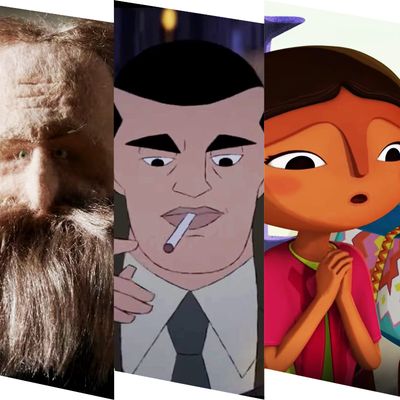
Aside from the obvious, the animated films Frozen II, Buñuel in the Labyrinth of the Turtles, and Pachamama seem to have next to nothing in common. Frozen II is the Walt Disney Animation Studios box-office colossus that rolled like a downhill snowball, drawing in moviegoers on five continents to generate more than $1 billion globally. By contrast, the independently produced Buñuel arrived as a theatrical afterthought: a GKIDS-distributed animated biopic that chronicles a stranger-than-fiction chapter in the life of Spanish surrealist filmmaker Luis Buñuel. (It earned just $156,432 theatrically ahead of a streaming/download release.) Then there’s Pachamama, which can perhaps be best understood as a product of cross-border animation amity, now reaching 190 countries on Netflix. The French-Luxembourgian-Canadian co-production follows the journey of two Peruvian preteens who traverse the Andes by condor trying to retrieve a golden statue of worship.
What all three films do share, however, is a place in the history books. They are among the record-setting 32 movies submitted for consideration in the Best Animated Feature category at the 2020 Oscars. The pixelated pile-on — which also includes a full complement of big-budget sequels like Toy Story 4, The LEGO Movie 2: The Second Part, and How to Train Your Dragon: The Hidden World — represents a broadening of the field by five from the previous record in 2017. The deep bench of entries arrives amid what Pixar Animation Studios president Jim Morris recently described to Vulture as an “absolute explosion in animation.” It’s a time that has seen 2-D, stop-motion, and computer-generated animation alike mature beyond the niche of “family” entertainment to a broader, more diverse, and more adult audience. Recent tech advances have significantly lowered the animated field’s barrier to entry, giving tiny indies a real chance to square off against studio blockbusters in pursuit of Academy gold — not to mention opening the floor to entries from far afield of Hollywood.
“It’s unprecedented to have so many animated features submitted for the Oscars,” says Teresa Cheng, chair of USC School of Cinematic Arts’ John C. Hench Division of Animation & Digital Arts and a former DreamWorks Animation senior production executive.
It’s easy enough to forget that prior to 2001, the Oscars didn’t even have a dedicated Best Animated Feature category (although an animated-short-film Oscar has been around since 1932). The inaugural feature-length award was handed to Shrek in 2002, but it wasn’t until April of this year that the Academy finally made the Best Animated Feature a permanent fixture in its awards lineup. Previously the slot was only “activated” under a prescribed set of circumstances.
“The animation industry had been thought of as sort of a cottage industry for a long while,” says Max Howard, the former president of Warner Bros. Feature Animation and longtime Academy member who also oversaw Disney Animation Studio divisions in London, Paris, and Hollywood. “Disney owned the space and, really, were the only people making high-quality 2-D animated films. So at the start, the Academy had a provision that if there were less than eight animated films in release [in a calendar year], there would be no Oscar. From there, it would be three nominations if there were eight to 12 films, and four [nominations] if there were 12 to 16. Only if there were more than 16 films in release would there be five nominations.”
According to Bill Kroyer, the Academy Award–nominated writer-director-animator who served as senior animation director at Rhythm & Hues Studios, the widening battle royal for the category’s final five berths represents a kind of inevitable progress for the animated medium, which has been steadily gaining in critical acclaim and whose films have been taking in ever more princely box-office sums over the past two decades. “It’s not so much a watershed moment in animation as a continuation of the curve,” says Kroyer, who now serves as head of digital arts at Chapman University’s Dodge College of Film and Media Arts. “The number of animated films in the pipeline is absolutely astounding. What’s happening is you have your studio on a laptop. You can open your computer and download all the software you need to make a theatrical-quality animated feature film.”
This year especially, Netflix is flexing new muscle in the category, submitting its first original animated movie, Klaus, a Santa Claus origin story directed by Despicable Me filmmaker Sergio Pablos, in addition to Pachamama and I Lost My Body, a French-produced, adult-skewing dark comedy that won the Cannes Film Festival’s Nespresso Grand Prize, the first work of animation to claim that honor.
But the crowded field’s most aggressive, flood-the-zone offensive comes courtesy of the New York–based independent distributor GKIDS, which heads into the Oscars selection process with nine entries in the Best Animated Feature category. Among them: Okko’s Inn (from Japan, based on a series of manga children’s novels), the stop-motion colonialist critique This Magnificent Cake! (co-directed by Belgian filmmakers Emma De Swaef and Marc James Roels), and White Snake (a fantasy-wuxia-action thriller produced by China’s Light Chaser Animation Studios) — a decidedly mixed bag of international titles that also underscores animation’s new globalist streak. “Incredibly, [GKIDS] amounts for almost a third of this year’s contenders,” notes Alex Dudok de Wit, Europe editor of the animation-news website Cartoon Brew. “Plus, this year sees, I think, first-time entries from countries like Brunei and Iran, which signals that the medium of animated features isn’t just growing in quantity, but in reach, too.”
Adds Kroyer: “I just talked to a friend, a major director, who’s going to animate a film in Nepal. So anywhere in the world where human beings with talent can invest in some computers and set up a network, you’re in business.”
But can we reasonably expect any of these smaller films to stand a chance against Hollywood’s better-funded, bigger-promoted corporate product? Even with Disney’s The Lion King sitting out the Best Animated Feature proceedings to presumably gun for a Best Picture Oscar nomination (despite its photo-realism, the remake is all CGI and was nominated for a Best Motion Picture — Animated Golden Globe on Monday), is there a scenario in which a relatively obscure but indisputably exquisite entry like the watercolor-style animated The Swallows of Kabul could knock out, say, The Secret Life of Pets 2 or The Addams Family, to edge its way into the 92nd Academy Awards’ final five? To hear it from David Pruiksma, a veteran animator known for creating such indelible Disney characters as Beauty and the Beast’s Mrs. Potts and Pumbaa in 1994’s The Lion King, members of AMPAS’ animated branch are predisposed to value art more than commerce.
“I think the usual suspects will definitely be up there — it’s hard to beat a Pixar picture because of the sheer box office,” Pruiksma says. “But when it comes to the Academy Awards, it’s all about the arts, the sciences, and the technological and artistic sides of films. That’s really what should drive the awards, not box office or popularity. Neither I nor the people I talk to think that any academy of film should be driven by popularity. Voters are much more open than they used to be.”





